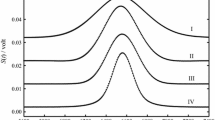Abstract
The dissolution kinetics of ionizable drugs (weak acids or bases) are analyzed with a mathematical model derived from the theory of mass transfer with chemical reaction. The model assumes that the overall process is diffusion limited, that all the reactions are reversible and instantaneous, and that dissolution and reaction are limited to the stagnant fluid film adjacent to the solid phase. Dissolution into buffered and unbuffered aqueous solutions are considered separately, with covenient analytical solutions obtained in both cases. In addition, equations for the time to partial and complete dissolution are derived. The dissolution rate is shown to be dependent on the pK a and intrinsic solubility and the medium properties, i.e., pH, buffer capacity, and mass transfer coefficient. Equations of a form analogous to the nonionized case are derived to account explicitly for all these factors, with dissolution rates expressed in terms of the product of a driving force (concentration difference) and resistance (inverse of mass transfer coefficient). The solutions are in an accessible analytical form to calculate the surface pH and subsequently the surface concentrations driving the drug dissolution. Numerical examples to illustrate dissolution into unbuffered and buffered media are presented and the results are shown to be in accord with experimental data taken from the literature.
Similar content being viewed by others
REFERENCES
W. Nernst. Z. Phys. Chem. 47:52–55 (1904).
A. Goldberg, In L. J. Leeson and J. T. Carstensen (eds.), Dissolution Technology, Industrial Pharmaceutical Technology Section, APhA Academy of Pharmaceutical Science, Washington, D.C., 1974.
E. Shek. Pharm. Ind. 40:981–984 (1978).
E. Brunner. Z. Phys. Chem. 47:56–102 (1904).
W. I. Higuchi, L. Parrott, D. E. Wurster, and T. Higuchi. J. Am. Pharm. Assoc. Sci. Ed. 47:376–383 (1958).
W. I. Higuchi, E. Nelson, and J. G. Wagner. J. Pharm. Sci. 53:333–335 (1964).
K. G. Mooney, M. A. Mintun, K. J. Himmelstein, and V. J. Stella. J. Pharm. Sci. 70:13–21 (1981).
K. G. Mooney, M. A. Mintun, K. J. Himmelstein, and V. J. Stella. J. Pharm. Sci. 70:22–32 (1981).
J. G. Aunins, M. Z. Southard, R. A. Myers, K. J. Himmelstein, and V. J. Stella. J. Pharm. Sci. 74:1305–1316 (1985).
J. B. Dressman and D. Fleisher. J. Pharm. Sci. 75:109–116 (1986).
W. Nernst and E. Brunner. J. Am. Chem. Soc. 47:52–102 (1904).
A. W. Hixson and J. H. Crowell. Ind. Eng. Chem. 23:923–931 (1931).
R. B. Bird, W. E. Stewart, and E. N. Lightfoot. Transport Phenomena, John Wiley and Sons, New York, 1960.
J. Crank. Mathematics of Diffusion, University Press, Oxford, 1975.
B. O. Palsson. In S. Siedeman and B. Bexar (eds.), Electrochemical Activation, Metabolism and Perfusion of the Heart Simulation and Experimental Models, Martinus Nijhoff, Wordrech/Boston/Lancaster, 1986.
R. Aris. The Mathematical Theory of Diffusion and Reaction in Permeable Catalysts, University Press, Oxford, 1975.
C. G. Hill, Jr. An Introduction to Chemical Engineering Kinetics and Reactor Design, John Wiley and Sons, New York, 1977.
T. K. Sherwood, R. L. Pigford, and C. R. Wilke. Mass Transfer, McGraw-Hill, New York, 1975.
V. G. Levich. Physico-chemical Hydrodynamics, Prentice-Hall, Englewood Cliffs, NJ, 1962.
J. Spitael, R. Kinget, and K. Naessens. Pharm. Ind. 42:846–849 (1980).
B. Carnahan, H. A. Luther, and J. O. Wilkes. Applied Numerical Methods, Wiley, New York, 1969.
Author information
Authors and Affiliations
Rights and permissions
About this article
Cite this article
Ozturk, S.S., Palsson, B.O. & Dressman, J.B. Dissolution of lonizable Drugs in Buffered and Unbuffered Solutions. Pharm Res 5, 272–282 (1988). https://doi.org/10.1023/A:1015970502993
Issue Date:
DOI: https://doi.org/10.1023/A:1015970502993




